|
|
|
Sort Order |
|
|
|
Items / Page
|
|
|
|
|
|
|
| Srl | Item |
| 1 |
ID:
116483
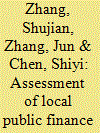

|
|
|
|
|
| Publication |
2012.
|
| Summary/Abstract |
Making use of the data envelopment analysis (DEA) technique and taking undesirable fiscal phenomena into account, this paper comprehensively quantifies the public finance performance of local governments in China during the course of fiscal decentralization reform. The introduction of undesirable fiscal outcomes into this assessment makes it possible to identify meaningful and informative characteristics of local public finance performance in China. When reforms are first implemented, local public financial performance improves because undesirable fiscal phenomena have not yet become too serious. The tax sharing system reform did not work well in its early stages, and negatively impacted public expenditure efficiency. The reform started to play a substantial role between 2001 and 2005, when local governments experienced better public finance performance. Corresponding to the deterioration of the financial sector in recent years, local public financial performance worsened after 2007. Further reform of the current fiscal and taxation system is necessary in China, to ensure a brighter future for the nation.
|
|
|
|
|
|
|
|
|
|
|
|
|
|
|
|
| 2 |
ID:
116480


|
|
|
|
|
| Publication |
2012.
|
| Summary/Abstract |
Although conventional international economic wisdom holds China's hardware and India's software industries to be equipotential, little attempt has been made to compare their information industries in an overarching dynamic framework. Using a schema that links intellectual to financial value creation, it is found that China has systematically moved ahead in creating a self-supporting industrial and innovation ecosystem. Hardware enjoys higher barriers to entry, which the Chinese companies are increasingly reinforcing with intellectual property investments. In addition to being better integrated with the global economy, they are also buttressed by the huge domestic market. The overdependence of Indian firms on selling low-value services to a few countries and insulation from domestic demand make them vulnerable to emerging competition and international economic ill-winds. The two countries provide a study in contrast on the effects of divergent industrial strategies.
|
|
|
|
|
|
|
|
|
|
|
|
|
|
|
|
| 3 |
ID:
116461
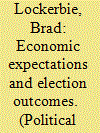

|
|
|
|
|
| Publication |
2012.
|
| Summary/Abstract |
Do our models of political behavior bear any resemblance to reality? Forecasting elections is one opportunity to assess whether our models of voting behavior are accurate. Over the past few decades, political scientists have been willing to put themselves out there to forecast elections. Explaining a past event allows us the ability to retrofit our models before we make them available to the broader community. In short, forecasting elections provides us the opportunity to develop humility. The forecasting community has done a reasonable job over the past few elections. Aside from 2000, forecasters have been largely accurate. Even in 2000, the forecasting community can claim a modest victory. The community was right about the popular vote winner; it just happened that the popular vote winner lost the election that counts-the Electoral College.
|
|
|
|
|
|
|
|
|
|
|
|
|
|
|
|
| 4 |
ID:
116451


|
|
|
|
|
| Publication |
2012.
|
| Summary/Abstract |
How relatively good or bad were the economic performances of our past presidents? The answers to this question remain unclear. Most evaluations of presidential performance cloud the issue with partisan bias and subjective judgments or mix economics together with other policy areas. To address these shortcomings, this article uses new data from the Measuring Worth Project to calculate the relative economic rankings of the United States presidents who served from 1789 until 2009. It analyzes up to 220 years of data on economic growth, unemployment, inflation, government debt, balance of payments, income inequality, currency strength, interest rates, and stock market returns to estimate an economic grade point average for each president. Then, these estimates are used to test for correlations with other variables to generate hypotheses regarding the conditions for superior and inferior economic performance.
|
|
|
|
|
|
|
|
|
|
|
|
|
|
|
|
| 5 |
ID:
116473


|
|
|
|
|
| Publication |
2012.
|
| Summary/Abstract |
Within the medical and physical sciences journals evidence suggests that problems of authorship ethics and journal management bedevil the editors of these journals. Although anecdotal evidence suggests that similar problems persist in political science, the extent of these problems within political science is not well established. Here we report the results of a survey of political science journal editors' perceptions of ethical and managerial issues associated with their journals. We find that unlike ethical publication concerns in the clinical and natural sciences fields, these issues are not of significant concern among our sample. Ethical problems are of low concern and editors report high levels of confidence to address these problems. Managerial problems, such as the adequacy of reviewer pools, are of higher concern to our sample.
|
|
|
|
|
|
|
|
|
|
|
|
|
|
|
|
| 6 |
ID:
116457
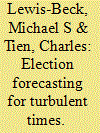

|
|
|
|
|
| Publication |
2012.
|
| Summary/Abstract |
Election forecasters face increasing turbulence in their relevant environments, making predictions more uncertain, or at least apparently so. For US presidential contests, economic performance and candidate profiles are central variables in most statistical models. These variables have exhibited large swings recently. Before the 2008 US presidential election, the economy fell into a Great Recession, and the candidate of one of the two major parties was, for the first time, a black man. These unprecedented conditions were trumpeted in the media, with heightened frenzy over the "horse race" question of who was going to win the White House. In the press, many forecasts appeared, taking different forms-polls, models, markets, pundits, to name some-offering a broader range of possible outcomes than ever before. Just looking at the predictions of the statistical modelers alone, we find that for 2008 many teams offered estimates of the incumbent (Republican) vote, ranging over an 11 percentage point spread. At one extreme, Lockerbie (2008) forecast 41.8% while at the other extreme Campbell (2008) forecast 52.7%. Of course, other methodologists offered their own, different, forecasts. The media, in its various forms, added to the hyperbole, aggressively reporting different forecasts on an almost daily basis.
|
|
|
|
|
|
|
|
|
|
|
|
|
|
|
|
| 7 |
ID:
116463
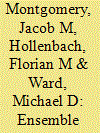

|
|
|
|
|
| Publication |
2012.
|
| Summary/Abstract |
For more than two decades, political scientists have created statistical models aimed at generating out-of-sample predictions of presidential elections. In 2004 and 2008, PS: Political Science and Politics published symposia of the various forecasting models prior to Election Day. This exercise serves to validate models based on accuracy by garnering additional support for those that most accurately foretell the ultimate election outcome. Implicitly, these symposia assert that accurate models best capture the essential contexts and determinants of elections. In part, therefore, this exercise aims to develop the "best" model of the underlying data generating process. Scholars comparatively evaluate their models by setting their predictions against electoral results while also giving some attention to the models' inherent plausibility, parsimony, and beauty.
|
|
|
|
|
|
|
|
|
|
|
|
|
|
|
|
| 8 |
ID:
116455
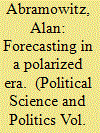

|
|
|
|
|
| Publication |
2012.
|
| Summary/Abstract |
The 2012 presidential campaign takes place at a time of deep political division in the United States. Democrats and Republicans differ sharply over Barack Obama's performance in office as well as a wide range of issues ranging from government spending and health care to immigration and gay marriage. These divisions are shaping the strategies of the candidates and the outlook for November. Overwhelming majorities of Democrats and Republicans, including overwhelming majorities of independents who lean toward a party, can be expected to support their own party's nominee. As a result, the outcome will depend on which party does a better job of mobilizing its supporters and appealing to a small group of swing voters in 10 or 12 battleground states.
|
|
|
|
|
|
|
|
|
|
|
|
|
|
|
|
| 9 |
ID:
116453
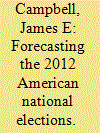

|
|
|
|
|
| Publication |
2012.
|
| Summary/Abstract |
This symposium presents 13 articles forecasting the 2012 US national elections. Included in this collection are the eight national and one state presidential vote forecasting models published in PS: Political Science & Politics during the 2008 elections along with three additional forecasts and one article offering a composite of the forecasts. Although the focus remains on the presidential contest, as in past years, several articles extend their scope to cover the congressional elections as well.
|
|
|
|
|
|
|
|
|
|
|
|
|
|
|
|
| 10 |
ID:
116466
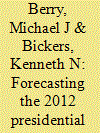

|
|
|
|
|
| Publication |
2012.
|
| Summary/Abstract |
Nearly all forecast models of US presidential elections provide estimates of the national two-party vote (Campbell 2008). Each of the nine forecasts published in the 2008 forecasting issue of PS: Political Science and Politics made national popular vote total predictions for the major party candidates, while only one provided an expected result in the Electoral College (Klarner 2008). These national vote models are assumed to be reliable forecasts of who is likely to win the general election. In most cases, this assumption is reasonable. It becomes problematic, however, at precisely the point that forecasts are most interesting: when elections are close. In tight elections, national forecasts can and have produced a "winner" different from the actual winner. Consider the forecasts and ultimate outcome of the 2000 election. Each of the 2000 presidential election forecasts predicted vice president Al Gore to win a majority of the two-party popular vote, which he did, but none correctly predicted governor George W. Bush to assume the presidency (Campbell 2001). Never in US history have White House residents been determined through a national popular vote. Presidential elections are decided through contests in the states and the District of Columbia. The forecast model we developed explicitly models the presidential contest based on factors inherent to these 51 jurisdictions. This modeling approach allows us to make a projection of the Electoral College result, which popular vote estimates cannot.
|
|
|
|
|
|
|
|
|
|
|
|
|
|
|
|
| 11 |
ID:
116462


|
|
|
|
|
| Publication |
2012.
|
| Summary/Abstract |
In March 2009, at a time when President Obama was basking in the glow of the honeymoon with the public every new president enjoys, I asked, "Will Barack Obama be a one-term president?" What prompted me to pose so impertinent a question at so hopeful a time was that the Office of Management and Budget was projecting that that year the federal government would spend 28% of gross domestic product (GDP). This amounted to a 7% point increase compared to the previous year, the largest peacetime one-year jump since 1930. The most recent estimate for 2012 is that federal outlays will take up 24.3% of GDP, up 3.5% points since 2008. This is the second-largest peacetime increase from one election year to the next since 1880, edged out only by Franklin D. Roosevelt's first-term surge of 3.6% points.
|
|
|
|
|
|
|
|
|
|
|
|
|
|
|
|
| 12 |
ID:
116465
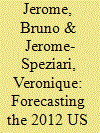

|
|
|
|
|
| Publication |
2012.
|
| Summary/Abstract |
Since 2008, the economic fallout from the subprime mortgage crisis has led to the defeat of a number of incumbents in the world's major democracies. For instance, in the former EU-15, eight countries (including France) have ousted their incumbents in favor of new leaders. The United States is no exception, and the 2012 US presidential election will see Barack Obama running for a second term during difficult economic times. After hitting a high of 10% in October 2009, the nation's unemployment rate decreased to 8.2% in May 2012. Nonetheless, this is still 0.7 percentage point higher than what Ronald Reagan faced in 1984 or what confronted George H.W. Bush in 1992 as they ran for their second terms. Looking at measures of presidential popularity for the month of May since 1980, Barack Obama's approval rating is at 46% in the Gallup polls, which is the third-worst rating after George W. Bush (30% in 2008) and George H.W. Bush (39.4% in 1992). Given Barack Obama's approval rating and the current national unemployment level, must we conclude that Barack Obama is irremediably on the ropes against Mitt Romney in 2012?
|
|
|
|
|
|
|
|
|
|
|
|
|
|
|
|
| 13 |
ID:
116458
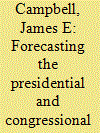

|
|
|
|
|
| Publication |
2012.
|
| Summary/Abstract |
This article presents forecasts of the 2012 presidential and US House of Representatives elections. The presidential forecasts are of the national two-party presidential vote percentage for the in-party candidate and are based on the trial-heat and economy forecasting equation and its companion convention-bump equation. The House election forecast is of the net seat change for the Democratic Party from 2010 to 2012. This forecast is produced from two versions of a seats-in-trouble forecasting equation.
|
|
|
|
|
|
|
|
|
|
|
|
|
|
|
|
| 14 |
ID:
116454
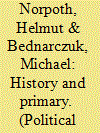

|
|
|
|
|
| Publication |
2012.
|
| Summary/Abstract |
Democrat Barack Obama is going to defeat Republican Mitt Romney by a comfortable margin in the 2012 presidential election. This forecast comes from a statistical model that uses the primary performance of the candidates and a cycle in presidential elections to predict the presidential vote. In plain English, Obama has history on his side as well as the fact that he was unchallenged in the primaries. The model, called The Primary Model because of its heavy reliance on primaries, covers elections from 1912, the beginning of presidential primaries. Since 1952, however, only the New Hampshire Primary is used; we justify the choice of New Hampshire at some length.
|
|
|
|
|
|
|
|
|
|
|
|
|
|
|
|
| 15 |
ID:
116475


|
|
|
|
|
| Publication |
2012.
|
| Summary/Abstract |
This article introduces the writing metaphor and examines why political scientists should consider developing one to describe their own writing process. Drawing on the author's experience with writing accountability groups, it defines the components of the writing metaphor, provides an example, and discusses its advantages and disadvantages. The article argues that the writing metaphor can clarify scholars' implicit assumptions about the act of writing and the writing product and reveal unexpected information about their work habits and thinking process. By doing so, the writing metaphor can increase scholars' productivity and may ultimately enhance their writing experience.
|
|
|
|
|
|
|
|
|
|
|
|
|
|
|
|
| 16 |
ID:
116481
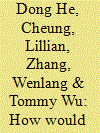

|
|
|
|
|
| Publication |
2012.
|
| Summary/Abstract |
In this paper we study the determinants of gross capital flows, project the size of China's international investment position in 2020, and analyze the implications for the renminbi real exchange rate if China liberalizes the capital account. We assume in this exercise that the renminbi will have largely achieved capital account convertibility by the end of the current decade, a timetable consistent with recent proposals by the People's Bank of China. Our analysis shows that if the capital account were liberalized, China's gross international investment position would grow significantly, and inflows and outflows would become much more balanced. The private sector would turn its net liability position into a balanced position, and the official sector would reduce its net asset position significantly, relative to the country's GDP. Because of the increasing importance of private sector foreign claims and the decreasing importance of official foreign reserves, China would be able to earn higher net investment income from abroad. Overall, China would continue to be a net creditor, with the net foreign asset position as a share of GDP remaining largely stable through this decade. These findings suggest that the renminbi real exchange rate would not be particularly sensitive to capital account liberalization as capital flows are expected to be two-sided. The renminbi real exchange rate would likely be on a path of moderate appreciation as China is expected to maintain a sizeable growth differential with its trading partners.
|
|
|
|
|
|
|
|
|
|
|
|
|
|
|
|
| 17 |
ID:
116460


|
|
|
|
|
| Publication |
2012.
|
| Summary/Abstract |
Although research at other levels of elected office has shown that incumbency has a powerful, additive effect on votes (Hogan 2004; Jacobson 2009; Krebs 1998), these effects largely have been ignored in presidential forecasting models (but see Abramowitz 2008). Instead, some scholars speculate about the conditional effects of incumbency; specifically, the decreased applicability of the retrospective model when the president is not on the ticket leaving the somewhat-harder-to-blame-or-reward vice president to represent the administration. The difficult-to-predict 2000 presidential election generated some discussion on this point. Although I and others argued (Campbell 2001; Holbrook 2001; Wlezien 2001) that part of the explanation for the forecasting error in 2000 lies with Al Gore's failure to embrace the Bill Clinton-Al Gore record and reinforce retrospective voting, others indicate that the retrospective cue may generally be weaker when the president is not on the ticket (Campbell 2001; Lewis-Beck and Tien 2001; Nadeau and Lewis-Beck 2001). Indeed, Campbell (2001; 2008) argues in favor of only giving half weight to presidential performance variables when the vice president, rather than president, is representing the incumbent administration. The logic here is simple: absent the president on the ticket, it is more difficult to frame the election as a referendum, leading voters to attach less weight to incumbency-oriented considerations. This is not to say that factors such as presidential approval and economic performance are unimportant when incumbents do not run, only that these factors might matter less.
|
|
|
|
|
|
|
|
|
|
|
|
|
|
|
|
| 18 |
ID:
116474
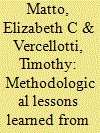

|
|
|
|
|
| Publication |
2012.
|
| Summary/Abstract |
With the growing size of the "Millennial Generation" and its potential impact on American democracy, the civic education of this cohort deserves study. Using news media and discussion of politics at home and in the classroom at four public high schools in New Jersey, we conducted an experiment to measure changes in media use, political knowledge, and political efficacy. Although the experiment generated useful substantive findings, we also learned important lessons about the challenges associated with conducting research in high schools. We present suggestions to aid in studying a crucial segment of the population: adolescents who are on the cusp of entering the electorate.
|
|
|
|
|
|
|
|
|
|
|
|
|
|
|
|
| 19 |
ID:
116450
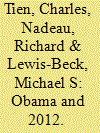

|
|
|
|
|
| Publication |
2012.
|
| Summary/Abstract |
Will President Obama lose votes in 2012 because of racial prejudice? For 2008, we estimated, via a carefully controlled, national survey-based study, that on balance he lost about five percentage points in popular vote share due to intolerance for his race on the part of some voters. What about 2012? There are at least three possibilities: (1) the presidency has become postracial, and the vote will register no racial cost; (2) intolerance has increased, and the vote will register an increased racial cost; and (3) intolerance has decreased, and the vote will register a decreased racial cost. Our evidence, drawn from an analysis comparable to that carried out for 2008, suggests Obama will pay a racial cost of three percentage points in popular vote share. In other words, his candidacy will experience a decrease in racial cost, if a small one. In 2008, this racial cost denied Obama a landslide victory. In the context of a closer election in 2012, this persistent racial cost, even smaller in size, could perhaps cost him his reelection.
|
|
|
|
|
|
|
|
|
|
|
|
|
|
|
|
| 20 |
ID:
116459
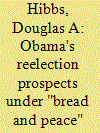

|
|
|
|
|
| Publication |
2012.
|
| Summary/Abstract |
According to the Bread and Peace Model postwar, American presidential elections should be interpreted as a sequence of referendums on the incumbent party's record during its four-year mandate period. In fact postwar aggregate votes for president are well explained by just two objectively measured fundamental determinants: (1) weighted-average growth of per capita real disposable personal income over the term, and (2) cumulative US military fatalities due to unprovoked, hostile deployments of American armed forces in foreign wars. No other outside variable systematically affects postwar aggregate votes for president.
|
|
|
|
|
|
|
|
|
|
|
|
|
|
|
|
|
|
|
|
|